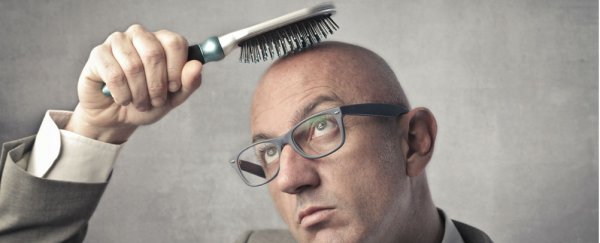Nobody wants to lose their hair, but the sad truth is that some of us will. Luckily, there could be good news on the horizon for those of us whose hairlines are doomed.
New research suggests that selectively plucking hairs in very close proximity can stimulate some startlingly dense regrowth.
The team behind the study, led by researchers at the University of Southern California (USC) in the US, demonstrated that by carefully extracting 200 hairs, one-by-one, from the back of a mouse in a specific configuration and density, they could trigger the growth of around 1,200 new hairs in the area - a five-fold increase.
While it's very early days, the researchers say their findings, which were reported in the journal Cell, could pave the way for new treatments for balding, or alopecia.
Previous studies have shown that nearly 50 percent of men between the ages of 40 and 49 might experience some form of balding. While male pattern balding, known as androgenic alopecia, is estimated to affect about 6.5 million men in the UK, and more than 35 million men in the US.
So how does one plucked hair prompt five new ones to sprout up? It almost sounds to good to be true.
Well, the researchers say that the trauma caused by the hairs being plucked triggers an immune response, as the skin follicle sends out a kind of distress signal via the release of inflammatory proteins.
This causes immune cells to rush to the site of the injury.
As the researchers explain, these immune cells secrete a molecule in response and this signals to the plucked follicle, and other skin follicles in the vicinity, that it's time to grow new hair.
"We've made a discovery about how hair communicates when it's distressed," Phillip Murray, a mathematician at the University of Dundee in the UK, who co-authored the paper, told Hannah Devlin at The Guardian.
Interestingly, the regeneration is very dependent on the pattern of the pluck. When the team pulled 200 hairs from an area on the mouse's back exceeding a 6 mm-wide diameter, they didn't observe any regrowth at all.
But when they repeated the process, plucking individual hairs in circular areas between 3 and 5 mm, they saw some big returns, with between 450 and 1,300 new hairs emerging. In some cases, these new hairs even grew outside the plucked region.
As Hannah Devlin explains for The Guardian, "the authors believe that hair follicles do not simply respond individually to being plucked, but also communicate between themselves… and effectively make a group decision about the level of immune response that is necessary."
Basically, if the follicles are too far apart, they can't signal collectively as a group. This means no immune response, and no hair growth. But if the plucking is closely packed together, the follicles can work together to coordinate a stronger immune response, stimulating lots of new hair growth.
Developmental biologist Cheng-Ming Chuong from USC, who led the study, says the results could have wider implications for regenerative medicine.
"The implication of the work is that parallel processes may also exist in the physiological or pathogenic processes of other organs, although they are not as easily observed as hair regeneration," he said in a press release.
The team hasn't yet outlined how it might turn this nifty bit of research into a treatment for balding, but we can dream.
Considering my grandfathers were both bald, my dad's pretty thin on top - despite his best efforts at comb-over deception (sorry dad) - the fate of my hair is pretty much a foregone conclusion.
I could embrace it, and begin brushing up on GQ's Guide to Balding with Style, or I could pluck like crazy. Beginning NOW.
Source: The Guardian
